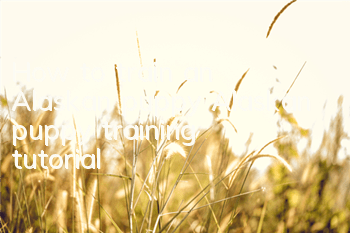Alaskan Puppy Training Tutorial:
Using the appetite reflex
Before feeding an Alaskan dog or when the dog is hungry, the trainer holds the food bowl or holds the food and stands outside the kennel door to lure the dog. The dog becomes very excited due to its eagerness to obtain food. At this time, if you give commands and gestures, and at the same time tease the dog with food, the dog can bark. In the early stage, as long as the dog shows signs of barking, the dog should be rewarded with food immediately. Eat a little less, and then let the dog bark. After barking, give him some food, and train like this for five or six times in a row. This is more effective for dogs with a dominant food response. In the future training, the food temptation can be gradually reduced until it is completely eliminated, and the training location should be changed frequently to make the dog bark completely according to the command and gesture.
Use defensive reflection
When the dog barks when he finds a stranger or other dog approaching in the house, the trainer can promptly issue commands and gestures to command the dog to bark and reward it. You can also bring the dog to yourself and let the assistant trainer slowly approach the dog from a distance and tease the dog. When the dog's attention or alertness is aroused, the trainer points to the assistant trainer with his right hand and barks to the dog. " command to stimulate the dog's excitement. When the dog barks or shows signs of barking, it should be rewarded immediately with the "good" command and pats. The assistant trainer will take the opportunity of the trainer to reward the dog, stop teasing or hide. Then continue teasing the dog to bark. In this way, after several trainings, basic conditioned reflexes can be formed. In the future, the trainer's teasing can be gradually reduced and eliminated, and only commands and gestures can be used to cause the dog to bark. This method is more effective for dogs with dominant active defense reactions. However, it should not be used too much to avoid the dog developing a bad relationship of barking when seeing people.
Using attachment
Take the dog to a strange and quiet place and tie it to a solid object. The trainer first tries to arouse the dog's excitement, and then immediately leaves the dog and walks to a certain distance, calling the dog's name while walking. The dog will become anxious and bark when it sees the trainer walking away and hears its name being called. At this time, the trainer should immediately use commands and gestures to command the dog to bark. After barking a few times, he will run to the dog and give pats and food rewards. Do this for two or three times of border training, and then let the dog roam. In future training, the distance away can be gradually shortened until the dog can bark without leaving.
Use free reflection
When dogs are confined for a long period of time and cannot move freely, dogs will express their eagerness to get out of the kennel. Therefore, you should use the barking command and gestures to command the dog to bark before letting the dog out of the house. If the dog barks, let the dog out of the kennel to reward the dog.
Use hunting reflection
It is most convenient and quick to pick up an excited dogThe training method of Jie is to use the desire to pick up. After using items to attract the dog, use the barking command or gestures to direct the dog to bark. If the dog can bark, reward the dog with something; if the dog is excited and does not bark, you should suddenly tie the dog to a fixed object while guiding the dog, leave the dog, continue to guide and command the dog to bark, such as If the dog can bark, you should return to the dog immediately to reward the dog.








